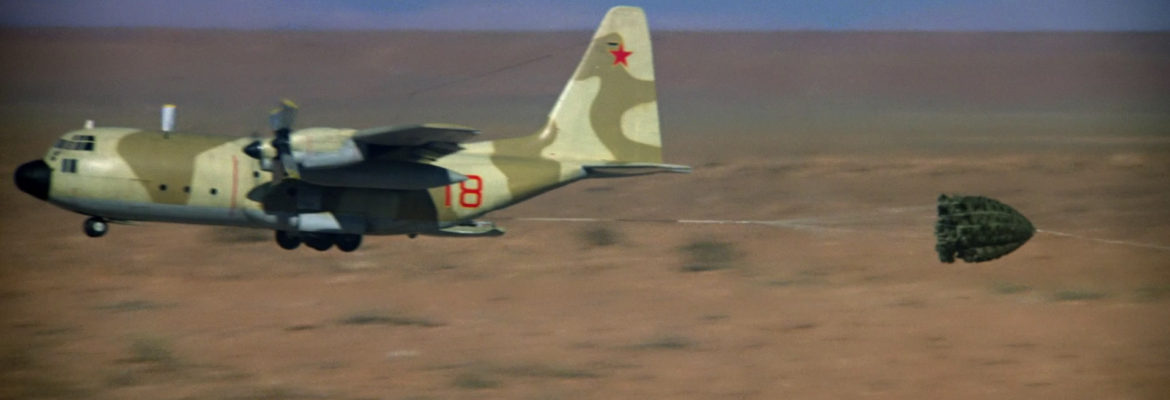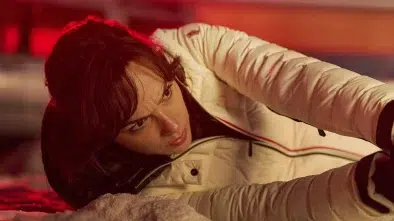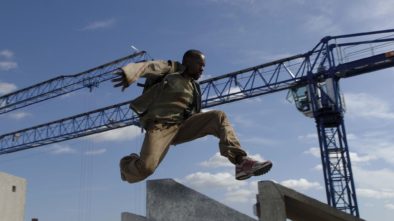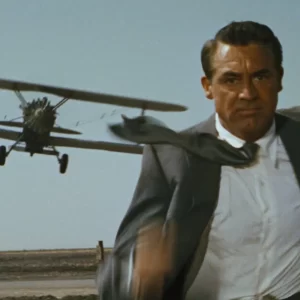‘The Living Daylights’: Old School Miniature Effects Helped Give The Hercules Cargo Plane Sequence An Epic Scale
The standout action sequence in The Living Daylights involves a Lockheed Hercules C-130 cargo plane that is certainly put through its paces, and then some. Afghan freedom fighters help James Bond storm a Soviet airbase so he can commandeer a cargo plane and stop an illegal shipment of heroin from hitting the streets and turning a huge profit for rogue Russian General Koskov and illicit arms dealer Brad Whittaker. As Bond takes off, the cargo plane narrowly misses another plane landing on the same airstrip. But the troubles for Bond–and the cargo plane–don’t end there. After fighting henchman Necros on a bag hanging out the back of the plane, Bond must drop a bomb on a massive bridge to cut the Soviet force off from the fleeing Afghans. Finally, Bond must escape the cargo plane via a jeep on a parachute before it crashes into a rockface.
The signature stunt in the sequence is the amazing mid-air fight on a bag hanging out the back of the Hercules. What is surprising is that this is one of the few scenes that does not use miniatures. The miniatures are so realistic, even today, and they give this sequence such a large-scale feel. This is because the miniatures achieve the impossible. They add large-scale elements to sequences that are not even possible in a Bond film or are just not safe to do as a live-action stunt. Although all the model work was filmed over 35 years ago in 1986, even today, they almost seamlessly mesh with the live-action stuntwork without a trace.
John Richardson, who had been creating amazing special effects–especially miniatures–for Bond since Moonraker, headed a team that created all these wonderful miniatures. Richardson and his team built three Lockheed Hercules C-130 miniatures, a foreground miniature bridge with background terrain, a full-size mockup of the cargo plane’s ramp, miniature jeeps, another plane, and even a miniature parachute. The eagle-eyed will notice that the miniature cargo planes are actually a different make and model of plane to the real one filmed in live-action. The four-engine Hercules C-130 made in miniature is different from the smaller, two-engine Fairchild C-123 Provider model. The full-scale Provider was cheaper to rent, and supplied by the Royal Moroccan Air Force. The Moroccan airforce also allowed the Bond team to transform Ouarzazate Airport into a Soviet base. Richardson and his team were based there and in surrounding areas for the majority of The Living Daylights shoot where they shot the following miniature scenes.
Two Model Planes Narrowly Miss Each Other–And The Real Plane Narrowly Misses The Cameraman’s Head.

After Kara drives her jeep onboard, Bond taxes down the runway unaware that another plane is about to land just ahead of him. The two planes narrowly miss as Bond pulls the heavy cargo plane off the tarmac. It’s a pulse-pounding moment, involving 12th-scale miniatures of the two planes, and Koskov’s 12th-scale jeep following behind. The Hercules goes out of shot. The next shot of the Hercules is a sixth-scale miniature which gave the film crew better angles to shoot. “We could get the camera lower and see the plane come along and hit the armored car and the wing take the top off the armored car,” Richardson told American Cinematographer.
Richardson operated a remote-controlled Hercules capable of taking off. The scene works well, especially because the miniatures blend so well with the close-ups of the actors. As Bond takes off in the final scene, we see Bond’s POV of the real plane coming into land. To capture this POV shot, the crew mounted a camera to the roof of a camera car. Richardson remained on top of the car to maintain stability for the shot. As the car drove towards the landing plane, Richardson was unaware of just how close the plane’s wheels were to his head. While he was busy looking through the camera’s viewfinder, onlookers witnessed the hair-raising moment Richardson’s head passed between the wheels of the low-flying plane’s landing gear.
The Foreground Miniature That Made The Bridge Look 200-Feet High–The Most Realistic Collapse of A Bridge Ever
The scene in which Bond drops a bomb from the Hercules C-130 onto a bridge, resulting in a complex explosion of timber cladding and its spectacular collapse into a deep ravine is two shots involving two miniatures: a foreground miniature and a 1/4 scale miniature rigged with explosives.
Location recces could not find a suitable bridge that matched the description of a huge bridge straddling a “huge ravine” in the screenplay. Production designer Peter Lamont suggested a modern-looking bridge, but it was only 8 feet off the ground over a stream. Richardson fixed the issue by using a time-tested solution: a foreground miniature. A foreground miniature is a small model that is placed in front of a real-life structure to give the illusion of extending it, adding a feature that is not there or covering up an existing architectural feature. Lined up correctly, the camera will record the miniature and the real structure as one seamless perspective-accurate match.
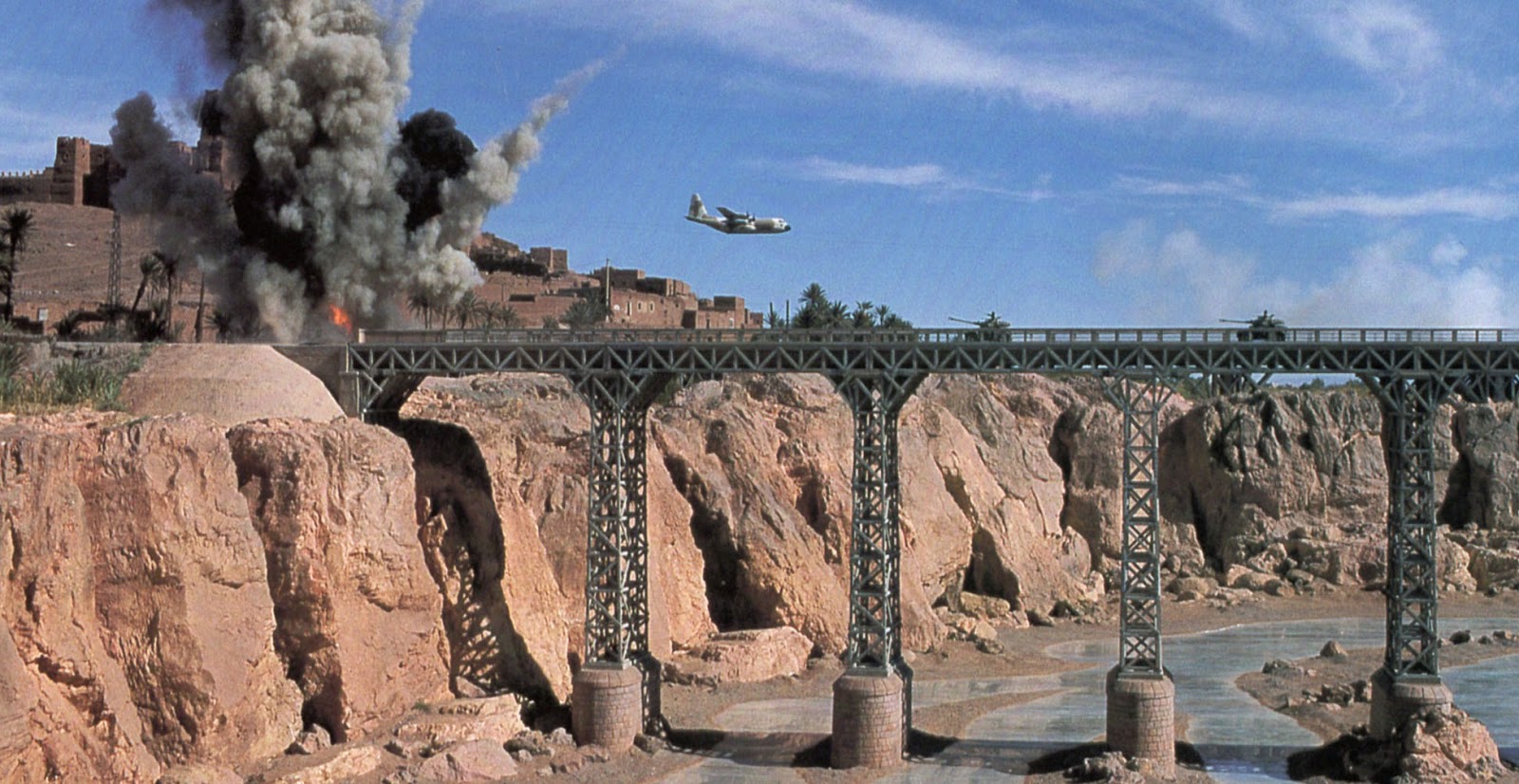
This still from the final film shows the real bridge matched with the foreground miniature. From the road up is the real bridge. From the road down is the foreground miniature. The 200-foot-high legs and the ravine behind it are the foreground miniature.
For the bridge, Richardson created one of his best foreground miniatures. He built a diorama, which included a four-and-a-half-foot high and twenty-foot long bridge fitted to a backdrop of plaster ravine walls and a river made from clingwrap covering a painted plywood base. The diorama was placed between the real bridge and the camera. It was only 23 feet from the camera, while the real bridge was 1,000 feet away to match both the foreground miniature and the real bridge into a unified perspective-correct structure. The camera was mounted on a nodal head fixed to a tripod which allowed director John Glen and cinematographer Alec Mills the ability to shoot the bridge at any angle they required.
The result is a spectacular optical illusion that really gives the sense that the bridge is 200 feet high. The foreground miniature was lined up perfectly with the handrail of the real bridge. The eye is tricked into believing the foreground miniature is full-scale because it seamlessly blends with the real bridge and the real tanks, and people on horseback moving back and forth over it. But even if you know the trick, it’s impossible to tell the difference between the real bridge and the foreground miniature. The camera also zooms to the corner of the bridge which gives a documentary feel to the shot and further sells its realism.
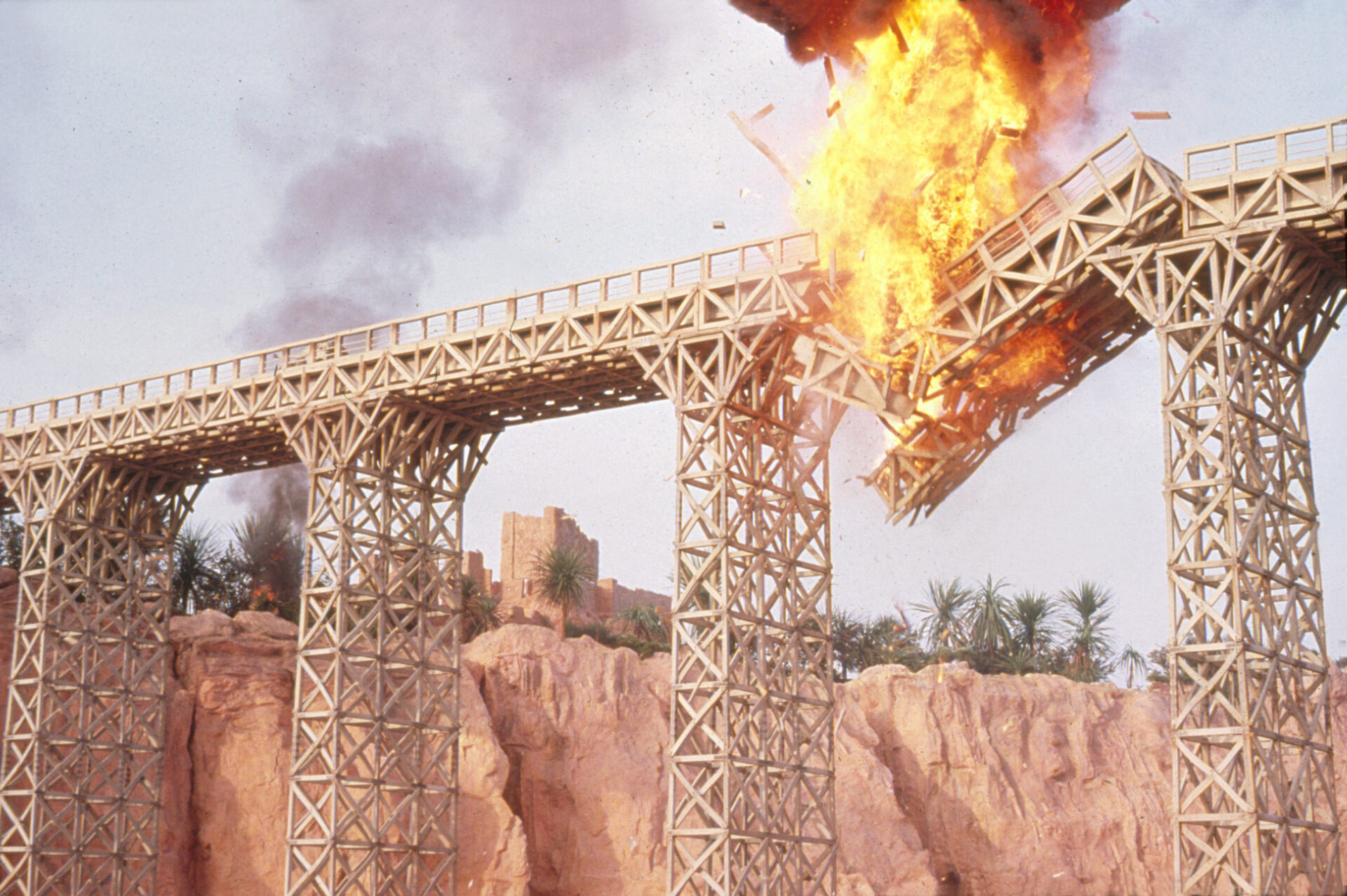
A 1/4 scale miniature bridge was blown up on the backlot at Pinewood Studios, London. (Image: moviestillsDB.com)
But the real difficulty in selling the miniature came in blowing it up. A 1/4 scale miniature (five feet high) was built over a little piece of the river and real rocks back at Pinewood Studios. The scale bridge was complete with detailed timber cladding that would detach and break apart in a similar fashion to much larger timber strutting on a real-life bridge. It was also specifically designed to collapse in sections and the result is one of the most spectacular and realistic bridge collapses on film. Of course, the camera was slowed down to the right speed which gives the miniature the right weight and feeling of size.
A Miniature Jeep Pulled Out The Back Of The Hercules–Moments Before A Miniature Hercules Slams Into Rockface

The ending of the sequence in which Bond and Kara’s jeep is pulled out the back of the cargo plane by a parachute required some ingenuity. Richardson filmed the scene. “The tricky thing was getting it at a predetermined altitude because it had to be something like two feet off the ground, which is very low,” recalled Richardson in the documentary Inside The Living Daylights. “We had a little radio-controlled drone parachute connected to a full-size model parachute which was connected to a little model of the jeep and the skid.”
The jeep is a combination of a 9″ long miniature, edited with shots of Dalton and D’Abo driving a specially rigged jeep through a wall shot in Morocco. They drove the jeep over a small ramp and landing which on camera gave the effect that the jeep had hit the ground. Dust explosions around the base of the jeep made it look like it hit the ground harder. This miniature shot was edited together with the shot of Dalton and D’abo in a full-size jeep going through a wall, which was shot in another part of Morocco.
Richardson later bought one of the Hercules that was left over from the shoot and blew it up on Iron Eagle 3.

